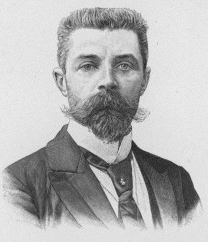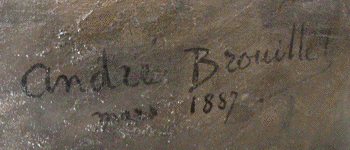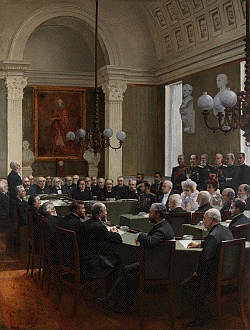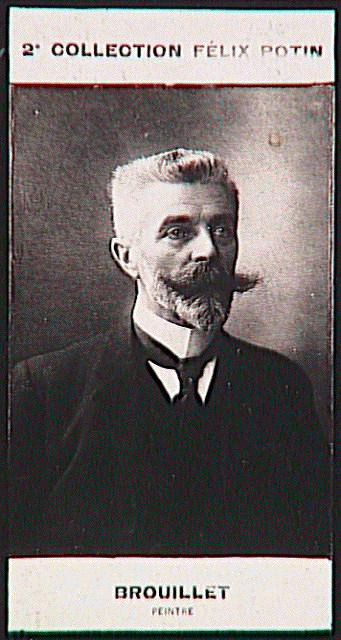 - Pierre-André Brouillet,
né à Charroux (Vienne) le 1er
septembre 1857
- décédé à
Couhé Vérac (Vienne) le 5
décembre 1914
-
- Fils de Pierre-Amédée
Brouillet, sculpteur, qui fut conservateur du
Musée des Beaux-Arts et directeur de
l'Ecole des Beaux-Arts de Poitiers, André
Brouillet entreprend des études
d'ingénieur avant d'entrer à
l'Ecole des Beaux-Arts où il est
l'élève de Jean-Léon
Gérôme (1824-1904). L'année
de sa réception au Salon, en 1879, il
suit les cours de Jean-Paul Laurens
(1838-1921).
-
- Alors que nait et prospère la
peinture impressioniste, Brouillet reste un
peintre très académique. Il est
célèbre pour sa toile Une
leçon clinique à la
Salpêtrière
présentée au Salon des
Indépendants de 1887). Jean
Martin Charcot est le personnage central
lors d'une de ses célèbres
séances du mardi, examinant la patiente
hystérique, Blanche Wittmann, soutenue
par Joseph
Babinski.
-
 -
 - voir
les noms des figurants
- présenté au salon de
1887 (3m *4,25m)
-
- "Un Leçon Clinique à la
Salpêtrière" (1887) by André
Brouillet can be seen near the entrance of the
"Musée d'histoire de la médecine",
"René Descartes University" 12, rue de
l'Ecole de Médecine, in Paris
5°.
-
- This big oil painting by the French artist
Pierre-André Brouillet is one of the most
known in the history of medicine. It represents
Jean-Martin Charcot
demonstrating in a clinical lecture to his
colleagues at the Salpêtrière that
the symptoms of hysteria were as real as those
of any organic disease. The patient is the
famous hysterical "Blanche" (Marie) Wittman, who
is supported by Dr.
Joseph Babinski.
-
 -
  -
 - L'ambulance de la
Comédie-Française en 1870
(1891)
-
- This big oil painting represents the
infirmary (fr.: ambulance) organized in the
foyer of the Comédie Française,
during the siege of Paris, in 1870. Also the
famous actress Sarah Bernhardt took care of the
wounded in this infirmary.
-
- It was painted in 1891 by French painter
André Brouillet and can be seen at the
top of the honour staircase of the "René
Descartes University" in 12, rue de l'Ecole de
Médecine, in Paris. As can be read on the
frame, the painting was a gift by the eclectic
physiologist and 1913 Nobel Prize for Medicine,
Charles Richet: he wanted to honour the memory
of his father, the physician Alfred Richet,
Professor of Clinical Surgery in the Faculty of
Medicine, who in the painting is represented in
the act of assisting a wounded soldier.
-
 - Le vaccin du croup à
l'hôpital Trousseau (1895) par Emile Roux,
disciple de Pasteur
-
- This picture highlights Dr.
Pierre Paul Emile Roux, a disciple of Louis
Pasteur and a former director of the Institute
Pasteur (1904-1933). He is most famous for
having discovered a diphtheria toxin secreted by
Corynebacterium diphtheriae, the
causative agent of diphtheria (which ultimately
lead to the vaccine).
-
 - Jules Ferry approuvant les plans de
la Nouvelle Sorbonne
-
 - Le Tsar, la tsarine, et le
Président de la République
assistant à une séance de
l'Académie française le 7 octobre
1896
-
 - Parisienne
- exposé au Salon des Artistes
Français de 1910
-
-
 -
-
 - Eau-forte de Charles
Martin (1884-1934)
|













